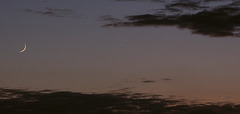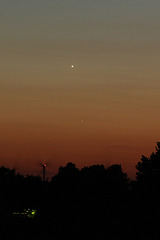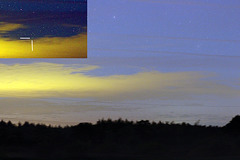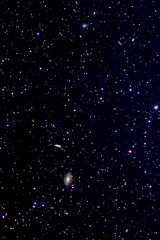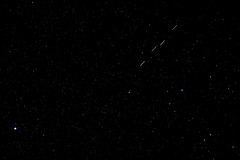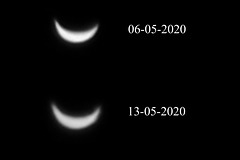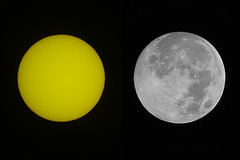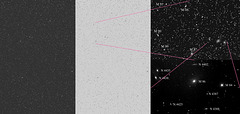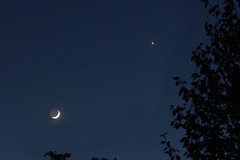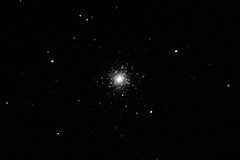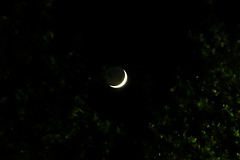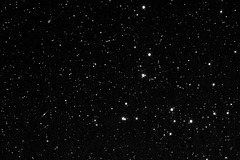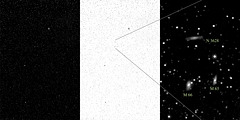
Astronomie
Folder: Astronomy
Abendpanorama (view on black)
| |
|
|
|
Mercury was visible with the naked eye and for Venus it was probably the last chance to see it as eveningstar. In a couple of days she will appear as morningstar
Venus and Mercury conjunction
| |
|
|
|
It is not very spectacular but I got no better ones. It was more cloud watching than planet watching.
Venus und Merkur am Abendhimmel
Comet Swan (C/2020 F8)
| |
|
|
|
21-05-2020, 01:08 Got it just before the clouds covered the area where to find comet Swan. The comet is just a few degrees above the horizon. It will get better in the comming days (weather permiting).
Canon EOS 700D with Samyang lens f=85 mm f/2,8, T=30 sec, ISO 1600 and tracked with VIXEN Polari
A useful link to find a.o. comets: theskylive.com/comets
Comet Panstarrs (C/2017 T2)
| |
|
|
|
Canon EOS 700D, Samyang lens f=85 mm, f/2,8 T= 100x 11 sec, ISO 1600, tracked with telescope. Cropped picture.
Panstarrs is in the Solar system at a distance from the earth (at this moment) of ~250 milj. km
The stars are in the Milkyway at a distance of 10 - 20 lightyears
The galaxies M81 and M82 are at a distance of ~11 milj. lightyears
Halbmond mit Erdschein
| |
|
|
|
Samyang Objektiv f=85 mm, f/2,8
Heute morgen früh aufgestanden um der Komet Swan zu erwischen, es war um 4:00 aber schon viel zu hell am Horizont. Stattdessen ein schöner Mondaufgang mit Halbmond und Erdschein (i.e. Leonardo da Vinci glow). Diese Kombination sieht man nicht oft.
www.timeanddate.de/astronomie/mond/erdschein
Zwei SpaceX Satelliten
| |
|
|
|
Als Nebenprodukt während der Suche nach der Komet Atlas. Zwei Bilder mit T=2 secunden kombiniert. Zeitspanne zwischen die Bilder ist ~6 secunden.
Samyang Objektiv mit f=85 mm, f/1.4, ISO 1600.
Sichel der Venus
| |
|
|
|
Der Sichel (kann man nur mit einem Teleskop sehen) wird die kommende Tage grösser und schmaler werden bis die Venus Richtung Sonne steht. Dann sehen wir (also nicht) die von der Sonne nicht beleuchteter Hälfte der Venus. Am 22. Mai steht Venus nahe Merkur, die Chance Merkur mal zu sehen.
Fasen der Venus.
www.lehrer-online.de/unterricht/sekundarstufen/naturwissenschaften/astronomie/unterrichtseinheit/seite/ue/venus-beobachtung-der-phasen-unseres-nachbarn/entstehung-der-venusphasen
Der erwähnte Merkurtransit Mercury transit part 2 (view on black)
Heute: Voll Sonne und Vollmond
| |
|
|
|
Canon 700D in prime focus of D=15 cm, f=750 mm telescope. For the Sun a filter was used. The pictures of sun and moon are on the same scale.
The Sun is still very inactive, there are no sunspots, the Moon, as usual, shows a lot of nice details.
Der Krater Schickhard als Beispiel
| |
|
|
|
Rechts eine Zeichnung von Tjomme de Vries ("De wereld van de Maan" 1968), die untere Darstellung ist perspektivisch korrigiert. Er benutzte dafür auch einen Newton teleskop mit D= 15 cm. Das Auge sieht mehr Details weil man dann für die "seeing" (Turbulenzen der Erdatmosfere) korrigieren kann.
Der Lichteinfal beim Bild und Zeichnung ist unterschiedlich. Das Bild ist gemacht beim Sonnenaufgang, kurz vor Vollmond. Die Zeichnung beim Sonnenuntergang, kurz vor Neumond
Virgo cluster
| |
|
|
|
Lucky to have in April more than a week clear skies. Time for the Virgo cluster. This galaxy cluster contains more than 5000 galaxies. It hosts a number of "famous" galaxies, a.o, M87 the jet and black hole elliptical galaxy
To the left: 10 x 15 degree area centered on the Virgo cluster
In the middle: a negative rendition of the left picture
Top right: a cropped version of the picture on the left
Lower right: a telescopic picture of the centre of the Virgocluster
Moon and Venus (view on black)
Virgocluster impressions
| |
|
|
|
Pictures made with Canon 700D in prime focus of d=15 cm and f=750 mm Newton reflector.
The Virgo cluster contains about 5000 galaxies, each galaxy contains more than 1000000000 stars
The globular starcluster M3
| |
|
|
|
containing about 500.000 stars it is one of the largest globular clusters of our Milkyway
en.wikipedia.org/wiki/Messier_3
Moon tonight
NGC 4631 (die Walgalaxie)
| |
|
|
|
und ihre Begleiter NGC 4627 und NGC 4656. Einer der ersten Galaxien die ich mit dem WSRT und VLA Radioteleskope beobachtet habe. Für mich eine sehr besondere Galaxie
Newton telescope D=15 cm, f=750 mm. Canon 700D in prime focus. T=50 x 15 sec. ISO 3200. Auisschnitt
Das Haar der Berenike (Coma Berenices)
| |
|
|
|
Das Haar der Berenike sind die helle Sterne (Melotte 111). Weiter sind zwei helle Galaxien, N 4565 und N 4559, zu sehen
Samyang lens f=85 mm, f/2,8, ISO 1600, T=50x15 sec. Ausschnitt
Die PiPs zeigen Bilder gemacht mit meinem Teleskop
Leo Triplet
| |
|
|
|
The Leo Triplet are three well known galaxies in the constellation Leo.
Left: Samyang lens f=85 mm, f/2,8, ISO 800, T=50x15 sec. An area of 10x15 degrees
Middle: same as left but negative to show details better..
Right a cropped picture to show the galaxies better.
PiP: used telescope f=750 mm D=15 cm (i.e. f/5). T=40x30 sec ISO 3200
Jump to top
RSS feed- Latest items - Subscribe to the latest items added to this album
- ipernity © 2007-2024
- Help & Contact
|
Club news
|
About ipernity
|
History |
ipernity Club & Prices |
Guide of good conduct
Donate | Group guidelines | Privacy policy | Terms of use | Statutes | In memoria -
Facebook
Twitter

